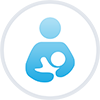Week 26
At week 26, your baby is 35-36 cm long from the top of their skull to their heels and weigh between 750 and 900 grams, so it won’t be long until they weigh a kilogram. They still have enough space to turn around and stretch, but with each passing week it gets harder for them and more exhausting for you.
The importance of iron
If you're not getting enough iron, you might find you've got a touch of anaemia, which will make you feel tired and low on energy. Your doctor or midwife tests for anaemia as part of your regular blood checks, but you can help guard against it by eating plenty of foods that are rich in iron.
Red meat contains a type of iron that's easy for your body to absorb, but if you're not a steak sort of person, you can tuck into non-meat sources such as lentils, soya mince or baked beans. You can even get a bit of your daily iron by nibbling on pumpkin seeds, dried apricots or cashew nuts.
If you're looking to maximise your iron absorption, make sure you eat or drink something that's high in vitamin C along with iron-rich foods - the vitamin C helps your body absorb iron better. On the other hand, drinks like tea, coffee and caffeinated soft drinks actually stop your body from absorbing iron, so you might not want to have a coffee straight after your lunch or dinner. Check the current recommendations on caffeine during pregnancy.
HiPP Organic fruit juice is a really good choice to drink when you’re pregnant, since it is high in vitamin C but also low in acidity, which means it's unlikely to cause heartburn (Bonus: it’s pure and organic too).
Are you eligible for Maternity Allowance?
If you're not eligible for Statutory Maternity Pay, you may still be able to claim Maternity Allowance. In order to claim this, you will need to submit your MAT B1 along with a completed MA1 form (available from your local job centre, social security office, maternity clinic/child health clinic or online) to your local Job Centre by the end of week 27.
What it’s like for the mum-to-be in week 26
Pregnancy bumps can vary in size. If this is your second pregnancy, you’ll notice that your bump has grown more quickly than it did in your first pregnancy – this is because your tissue has already been stretched. Other factors affecting the size of your bump include the position of your baby and the amount of amniotic fluid, but ultimately it’s simply about different body types: for instance, some women naturally have more flexible tissue than others, so their bump will expand more quickly.
Whatever size your bump is, it grows so fast from around week 26 that the hollow in your lower back may increase. Although this is a common occurrence, the back pain it causes can be avoided by adopting the right posture as
Gastrointestinal problems
The pressure the uterus puts on the surrounding organs makes it increasingly likely that you’ll suffer gastrointestinal problems. Feeling full after a meal may well be accompanied by heartburn and nausea, as your stomach is now smaller and can’t process the same amount of food as before.
The immune system in pregnant women is also less effective, as their body is having to deal with the additional challenges of pregnancy. So make sure you eat as much fresh food as possible (remembering which foods are “forbidden”) and prepare meals hygienically in order to avoid infections.
Stretch marks
Ultimately, there’s no way to fully avoid stretch marks – your connective tissue is stretched during pregnancy like never before and never again in your life. Your genes, the size of your bump and the amount of pressure on your skin will influence the extent to which you get stretch marks and tears in your skin tissue.
One thing you can do is regular massages with oil or skincare lotion, which will boost the elasticity of your skin. This will be most effective if you do it every day – establishing a routine will boost your wellbeing and avoid itchy skin and stretch marks.


